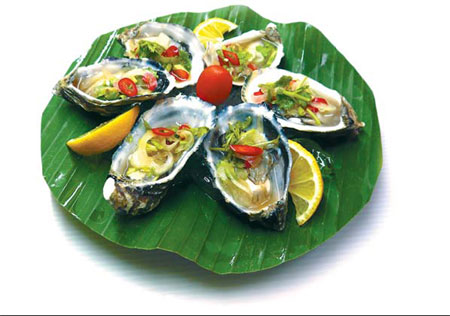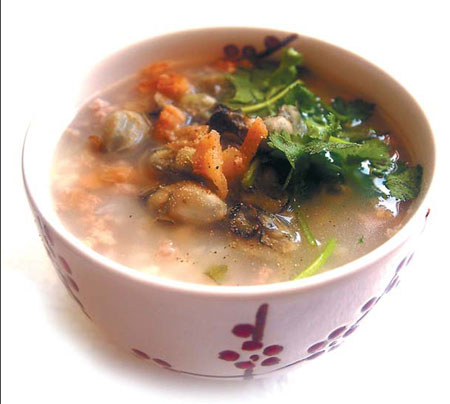Brrring on the oysters
Updated: 2011-11-06 14:20
By Pauline D. Loh (China Daily)
|
|||||||||

Photos by Pauline D. Loh / China Daily


World's your oyster? Even if it is not, it's time to discover the pleasures of this unique shellfish as the temperatures drop and their bellies get plump. Pauline D. Loh introduces you to the Chinese oyster.
Chinese oysters come in all shapes and sizes, and we love them all - from the monsters to the miniatures. There are the large shellfish traditionally farmed in Hong Kong New Territories and then there are the lovely little plump pearls oysters that come from the mouth of Guangdong delta. And of course, all along the coast all the way to Dalian in Liaoning province, there are more oysters, large and small.
Unlike Western gourmets though, Chinese seldom eat oysters raw. We steam them, bake them, fry them battered or naked, and we make a host of delicious dishes with them.
One of my favorite places to visit in Hong Kong 20 years ago was Laufoshan, a coastal village that used to be considered a rural destination. Now it sits opposite the tall condominiums of Shenzhen, and it has lost many of its oyster farms and seafood restaurants for which we would make the excursions.
At the end of the very, very long bus ride, the reward would be seafood, live fish swimming lazily in the tanks oblivious to their impending demise, and lots of oysters. If you took a walk past the restaurants that lined the pier, you would come upon scarved and hatted ladies busily shucking oysters.
Around them, there would be huge mountains of shells, which had reclaimed the shallow waters under the pier. Often, my friends and I would pick up a shell or two as souvenirs. They were huge, and perfect for cheap ashtrays.
We would then go order our meal - mainly steamed oysters with spring onions and ginger, deep-fried oyster fritters with a crisp batter that hid a just-cooked tender shellfish, a fresh fish steamed Cantonese-style and a platter of mustard greens from the farm next door.
Twenty years ago, the pollution was much less and we enjoyed our oysters with no thought of dangerous mercury levels. Those days are gone, and I believe most of the oyster farmers, too, have given up their fight with pollution.
Laufoshan also made the best oyster sauce, and sometimes I can still smell the salty, smoky aroma of the vats of oyster sauce brewing in my dreams. They were sweet and tasty, and had none of the gluggy texture that comes with added thickener.
A little further north, oyster omelets have become the iconic street food in Taiwan and Xiamen. But, the styles on the mainland and on the island are totally different. Taiwan oyster omelet is covered with a thick sweet starchy sauce and the omelet wears a base coat of green, mainly lettuce. In Xiamen, the green is garnish and the omelet has crispy edges that come from a slow frying of the sweet potato starch heavily laced with fish sauce.
Well, I am half-Fujianese, so I cannot help being partial to the mainland version, the recipe of which I have given below. Along the same coastal region, there are also two other delicious snacks made from oysters - an oyster pancake, and an oyster congee.
In winter, when the oysters are plump and fresh, the porridge more than warms my body. It warms my heart. The oyster dishes also remind me of my grandfather, an honest, almost illiterate Chinese emigrant who worked with his bare hands and never forgot the flavors of home.
If you'd like more stories on oysters, you can e-mail me at paulined@chinadaily.com.cn. Enjoy your oysters!
Recipe Oyster Omelet
Ingredients (serves two greedy gourmets):
500 g cleaned pearl oysters (see note)
100 g sweet potato starch plus 1 cup water
1 tbsp fish sauce
1 tbsp potato starch (extra)
1 tsp white pepper
2 eggs
Chopped coriander leaves for garnish
Method:
1. Mix the oysters with the potato starch and pepper.
2. Bring a small pot of water to a high boil and drop the oysters in. Count to 10 and then remove the oyster immediately. Drain and set aside.
3. Heat up a flat-bottomed frying pan over medium fire. When the pan is hot enough, add some oil to coat the bottom generously.
4. Mix together the potato starch and water and mix well. Add a small ladle of starch solution to the pan, swirling it around to spread it thinly. Leave to crisp until the starch turns totally transparent.
5. Break the eggs into the pan and spread them evenly over the starch base.
6. Add the oysters and sprinkle with fish sauce and more pepper to taste.
7. Flip the omelet to cook the oysters, and after a minute, flip it back and garnish with chopped coriander leaves. Serve immediately.
Food notes:
The oysters used here are the little shucked pearl oysters that are sold in plastic tubes at local fishmongers. They have to be washed several times to get rid of small bits of broken shell, and the slime that seems to stick to their skirts. Don t be discouraged by the process.
Wash the oysters thoroughly the first time, then throw out any broken or dubious ones. Clean your picked oysters and add 1 tablespoon of corn starch or all-purpose flour to the shellfish. Gently rub them with your fingers. This encourages the dark slime to stick to the flour. Rinse off the flour and slime and you have nice clean fat oyster meat. Give it a final rinse for good measure. They re now ready for use.
Recipe Oyster Pancakes
Ingredients (serves 4):
1 cup all-purpose flour
1 tsp baking powder
1 egg plus enough water to make a thick batter
200 g minced pork
500 g cleaned oysters
1 bunch coriander leaves, chopped
100 g mustard green (cai xin), chopped
Fish sauce
White pepper
Method:
1. Prepare the filling by seasoning the minced pork with fish sauce, salt and pepper. Fry the meat mixture until just cooked. Add the chopped coriander and mustard greens. Mix well.
2. Blanch the oysters, drain and add to the meat mixture.
3. Prepare the batter by mixing the flour, baking powder, egg and water to make a thick batter. You do not want it too wet or it will not hold its shape. Allow the batter to rest for about 30 minutes.
4. Prepare a flat frying pan and add enough oil to generously coat the bottom.
5. Place round spoonfuls of batter in the pan. Immediately place a heaped spoonful of filling on top of the batter.
6. Place another spoonful of batter on top to cover the filling. Keep your heat moderate so the pancake does not burn.
7. Flip the pancakes carefully without breaking them and fry until the other side is also golden. Keep finished pancakes warm in the oven as you complete the batch.
8. Serve immediately. Try not to keep these overnight as they have seafood in them. Besides, they are best eaten fresh.
Recipe Oyster Congee
Ingredients (serves 4):
500 g cleaned oysters
200 g minced pork
50 g Tianjin pickled vegetables (dong cai)
Salt and pepper to taste
Coriander leaves for garnish
1 cup rice
2 liters water
Method:
1. Heat the water, add the rinsed rice and bring to a boil. Turn down to a gentle simmer. You want to cook the rice until it just flowers, and not until it turns to sludge.
2. Season the minced meat with salt and pepper.
3. Rinse the Tianjin pickled vegetables to remove excess salt.
4. When the rice is softened and has blossomed, bring the congee to a boil and add the minced meat and Tianjin pickled vegetables. Stir vigorously to break up the minced meat.
5. When the meat is cooked, turn down the heat to a simmer.
6. In a separate pot of water, quickly blanche the oysters, and remove as soon as you see the skits curling up and the bellies are plump. Add to the congee.
7. Garnish and season with fish sauce and pepper to taste. Serve at once.
Food notes:
Blanching the oysters is to prevent them shrinking to oblivion, as they are want to do with overcooking. The layer of residual corn starch or flour will also create a protective layer around the oysters. Cooked this way, you get nice plum tasty oysters with your porridge.











